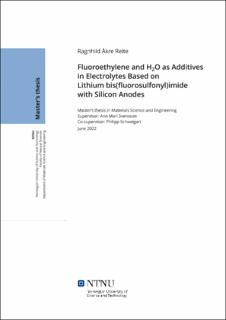| dc.contributor.advisor | Svensson, Ann Mari | |
| dc.contributor.advisor | Schweigart, Philipp | |
| dc.contributor.author | Reite, Ragnhild Åkre | |
| dc.date.accessioned | 2022-10-04T17:21:55Z | |
| dc.date.available | 2022-10-04T17:21:55Z | |
| dc.date.issued | 2022 | |
| dc.identifier | no.ntnu:inspera:108217718:34055088 | |
| dc.identifier.uri | https://hdl.handle.net/11250/3023777 | |
| dc.description.abstract | Effekten av fluoretylenkarbonat (FEC) og 1000 ppm H2O som tilsetningsstoffer i en elektrolytt basert på litium bis(fluorsulfonyl)imid (LiFSI) på silisiumanoder, ble studert med hensyn på syklingsevne, Coulombisk effektivitet, litierings/delitierings potensialer og motstand i elektroden. Det har blitt vist at tilsats av FEC forbedrer syklingsevnen til silisiumanoder ved å danne et mer stabilt "solid electrolyte interface" (SEI) på anoden, muligens grunnet økte mengder LiF i det indre laget av SEI, eller fleksible og passiverende polykarbonater i det ytre laget. Det har blitt rapportert at 1000 ppm H2O, i likehet med FEC, førte til forbedring av syklingsevnen til en LiNi_0,3Mn_0,3Co_0,3O_2/silisium celle. Derfor var målet med denne oppgaven å undersøke om H2O kunne erstatte FEC som tilsetningsstoff i batterielektrolytter.
Elektrolytter med etylenkarbonat (EC)/dimetylkarbonat (DMC) (1:1 masseforhold) og LiFSI-salt ble fremstilt og tilsatt enten ingen tilsetningsstoffer, FEC, H2O eller både FEC og H2O. Silisiumanoder med 75 vekt.% av enten amorft eller krystallinsk silisiumpulver ble kombinert med en av elektrolyttene og litium metall som motelektrode i en knappecelle, eller en LiFePO4 (LFP) katode i en PAT-celle. Elektrokjemiske tester og post mortem karakterisering, ved bruk av elektronmikroskop og Fourier-transform infrarød spektroskopi, ble utført på cellene.
Resultatene viste at FEC forbedret syklingsevnen til silisiumanodene, både med og uten tilsatt H2O, muligens på grunn av økte mengder polykarbonater fra reduksjon av FEC, og dannet et stabilt, fleksibelt og passiverende SEI. Tilsetning av FEC reduserte også den totale motstanden i elektroden. H2O som eneste tilsetningsstoff resulterte i lavere kapasitet og økt motstand sammenlignet med ingen tilsetningsstoffer.
Anodene syklet med FEC i elektrolytten oppnådde lavere Coulombisk effektivitet sammenlignet med elektrolyttene uten tilsetningsstoffer, eller kun H2O etter 100 sykler, muligens på grunn av høyere kapasitet, dermed større volumendringer. Det ble ikke observert noen forskjell i litierings/delitierings-potensialene med de forskjellige tilsetningsstoffene. For å konkludere, H2O kan ikke erstatte FEC som et tilsetningsstoff, ettersom FEC kreves for å danne et stabilt SEI, men silisiumanodene tåler 1000 ppm H2O i en LiFSI-basert elektrolytt. | |
| dc.description.abstract | The effect of fluoroethylene carbonate (FEC) and 1000 ppm H2O as additives in an electrolyte based on lithium bis(fluorosulfonyl)imide (LiFSI) on silicon anodes, was studied with respect to cycling performance, Coulombic efficiency, lithiation/delithiation potentials and electrode resistance. FEC has been shown to enhance the cycling performance of silicon anodes by improving the solid electrolyte interface (SEI) formed on the anode, possibly due to formation of LiF in the inner layer of the SEI, or flexible and passivating polycarbonates in the outer layer. It has been reported that 1000 ppm H2O showed the same enhancing properties as FEC on the cycling performance of a LiNi_0,3Mn_0,3Co_0,3O_2/silicon cell. Hence, the aim of this thesis was to investigate if H2O could replace FEC as an additive in battery electrolytes.
Electrolytes with ethylene carbonate (EC)/dimethyl carbonate (DMC) (1:1 mass ratio) and LiFSI salt were prepared with either no additive, FEC, H2O or both FEC and H2O. Silicon anodes with 75 wt.% of either amorphous or crystalline silicon powder were combined with one of the electrolytes and lithium foil as counter electrode in a coin cell, or LiFePO4 (LFP) cathode in a PAT-cell. The cells were subjected to electrochemical testing and post mortem characterisation using scanning electron microscope and Fourier-transform infrared spectroscopy.
The results showed that FEC drastically improved the cycling performance of the silicon anodes, both with and without additional H2O, possibly due to increased amounts of polycarbonates from the addition of FEC, forming a stable, flexible and passivating SEI. The addition of FEC also reduced the total electrode resistance. H2O as the only additive resulted in lower capacities and increased resistance compared to no additives. The anodes paired with electrolytes with FEC obtained lower Coulombic efficiencies compared to the electrolytes with no additives or just H2O after 100 cycles, possibly due to higher capacities, thus larger volume expansions. No difference in lithiation/delithiation potentials were observed with the different additives. To conclude, H2O can not replace FEC as an additive, as FEC is required to form a stable SEI, but the silicon anodes can tolerate 1000 ppm H2O in a LiFSI-based electrolyte. | |
| dc.language | eng | |
| dc.publisher | NTNU | |
| dc.title | Fluoroethylene and H2O as additives in electrolytes based on lithium bis(fluorosulfonyl)imide with silicon anodes | |
| dc.type | Master thesis | |
